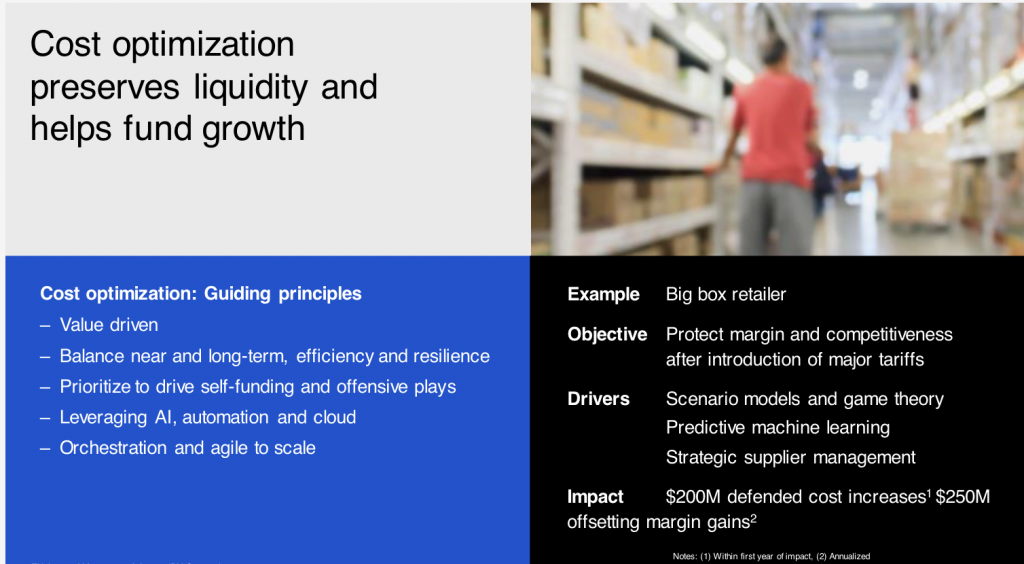COVID-19
The Crisis and Beyond: How to Cut Costs Intelligently
May 1, 2020 | Written by: Jamie Cattell
Categorized: COVID-19
Share this post:
 Because of revenue declines from the coronavirus pandemic, 25 percent of all global public companies could run out of cash in the next six months—unless they make a smart intervention. Preserving cash is, therefore, a huge imperative. But so is planning for the post-pandemic business world.
Because of revenue declines from the coronavirus pandemic, 25 percent of all global public companies could run out of cash in the next six months—unless they make a smart intervention. Preserving cash is, therefore, a huge imperative. But so is planning for the post-pandemic business world.
I’m a strategist for IBM Global Business Services, which has been working closely with clients to help them figure out how to save money in the short run, while also striding toward the future in the most strategic way.
Without such a strategy, too many companies cut costs in a linear, uncreative way that preserves cash but robs them of the capacity to flourish in the future. Too often, the impulse is to lay off people and let the organization figure out how to do more with less. But companies that cut the deepest do not usually rebound well from recessions.
Since the last big global economic challenge in 2008, we’ve developed powerful tools that help us figure out where money is being wasted, where overlaps occur, and where tasks can be streamlined or outsourced. We have better digital capabilities and more advanced AI to help us analyze companies’ structures and workflows. At IBM, we refer to these as intelligent workflows powered by data and exponential technologies. Application of intelligent workflows not only leads to greater cost savings (in the 50 to 70 percent range) than conventional belt-tightening approaches (10 to 20 percent)—but often also improves quality and effectiveness at the same time. Typically, belt-tightening degrades quality.
To thrive, companies need to employ these tools in making balanced cost reductions and placing offensive bets. If they are merely defensive, their rivals will pull ahead.
Client Cases
How does this work in practice?
Before this crisis, we helped a big box retailer achieve $500 million in savings, all without a single headcount reduction. We looked at ways to increase cash using other business levers. For instance, when we realized that new trade tariffs could hurt their suppliers and lead to price increases, we proactively helped them negotiate pricing.
We also worked with the client on evaluating price elasticity, understanding which products had to stay well-priced because that maintained the image of the store, and which items were not particularly price-sensitive. Sometimes, you can lower the prices of certain items and get so much more demand that you more than make up for the price cut.
 We have done similar work with our supermarket clients, helping them cut costs and yet improve the customer experience. This work, too, depends on deep analysis of sales and pricing. For instance, customers appreciate that stores carry shoelaces, and they don’t care that much what the price is. But they do notice, and care about, the prices of staples like milk and eggs. So it makes sense to raise prices on certain items and lower them on others.
We have done similar work with our supermarket clients, helping them cut costs and yet improve the customer experience. This work, too, depends on deep analysis of sales and pricing. For instance, customers appreciate that stores carry shoelaces, and they don’t care that much what the price is. But they do notice, and care about, the prices of staples like milk and eggs. So it makes sense to raise prices on certain items and lower them on others.
We also help them work with their suppliers, which allocate part of their budgets to promotion but don’t always make the best decisions on how to spend that money. For instance, running ads for already well-known brands may make little sense. Both supplier and store would benefit more if the same money is put toward price cuts, which would significantly raise sales.
It’s hard for stores, even large chains, to see these patterns because they carry tens of thousands of items. And usually a designated employee is responsible for the profit and loss statement of a particular category, and thus will do pricing based on what the competition charges. We have the tools to help them get a broader view, using analytics and AI to dig into historical events and buying patterns—not for a single category, but for thousands, based on up-to-date market patterns.
According to the U.S. Bureau of Labor Statistics, supermarkets, which on average have increased labor productivity by less than two percent in the last decade, need help in using digital tools to be more efficient. Many of them stock shelves just as they did decades ago, with associates walking the aisles and identifying gaps. Their time can be used more efficiently if stores use AI to tell them when a product is likely to need refilling. IBM can help them with tools that could show them, for example, how many slices of ham they likely will need in a certain week, with the reordering automated. That frees employees to focus more on customers.
Balancing the Human Factor
In working with our clients, we look at total value, and sometimes take headcount off the table. We’ve helped companies discover the overlaps and reduce costs by streamlining. We also study the operating model, to decide what is core to the business and what is not. Functions like personnel administration, payment processing, and accounts payable and receivable can be centralized and automated—saving money. But it makes no sense to reduce costs in the customer-facing part of the business, where you want to enhance the experience.
Automated procurement can also create cost efficiencies. Significant amounts of money can be saved by smarter buying of things like pencils and paper.
Sometimes, cost-saving involves analyzing processes. We worked with a large food company whose drivers not only deliver directly to stores but also put the product on the shelves. Previously, though, the drivers were often guessing what would be needed at a particular store. Through a cloud capability, we were able to give them a mobile application that, through a digital device, let drivers know exactly what was needed for each store on the route—and even where to put the product on the shelves to optimize sales.
Positioning for Post-Crisis Growth
Some steps do not cut costs now but prepare companies to thrive later. If headcounts are simply held flat, for instance, as companies grow they will likely see greater profit. The increased capacity can produce a better customer experience, reduce churn, or make it easier to raise prices and thus increase revenues.
During this pandemic crisis, it’s easy to see benefits accruing to retailers that were forward thinking and had invested in digital commerce. They are seeing a sales boom despite the troubled economy. Amazon, a company that has already invested in the infrastructure to make digital shopping easy, recently announced it would make 100,000 new hires during the coronavirus pandemic. Insurance companies that have invested in digital are doing much better than those still stuck in a system that depends on face-to-face sales.
Cognitive reinvention is the exciting part of our jobs, of our relationships with clients. We have so much more capability and technology that can help. Workplace automation, more analytics, AI—all of these tools and more can help control costs without ransoming future growth.

Jamie Cattell is Digital Strategy Global Leader at IBM.
Making the workplace safe for employees living with HIV
The recent promising news about Covid-19 vaccines is in sharp contrast to the absence of a vaccine for HIV, despite decades of research. Unlike Covid-19 with a single viral isolate that shows minimal diversity, HIV circulates in a wide range of strains that so far have proven impervious to a single vaccine. Fortunately, more people […]
Call for Code for Racial Justice Needs You: Join the Movement
IBM has never avoided taking on big challenges. At IBM, we are privileged to drive impact at scale. We take on challenges that transform our clients, impact people’s lives and innovate for future generations as we strive to effect systematic societal change. Over the course of our 109-year history, the evidence has become clear that […]
A New Wave: Transforming Our Understanding of Ocean Health
Humans have been plying the seas throughout history. But it wasn’t until the late 19th century that we began to truly study the ocean itself. An expedition in 1872 to 1876, by the Challenger, a converted Royal Navy gunship, traveled nearly 70,000 nautical miles and catalogued over 4,000 previously unknown species, building the foundations for modern […]


